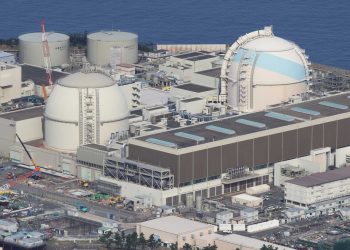,
Iran has begun installing centrifuges at the Natanz site where it plans 3,000 of the machines to enrich uranium in defiance of UN demands to halt this sensitive nuclear activity, diplomats have said.
And at the same time it is stopping UN inspectors from installing surveillance cameras in the huge underground hall where the production lines, or cascades, of centrifuges are being set up, the diplomats said.
Both moves would mark an escalation in the international showdown with Iran over a nuclear programme which the United States and others suspect is hiding secret development of an atom bomb, and on which the UN Security Council has levied sanctions to force Tehran to halt enrichment.
A diplomat in Vienna, where the UN watchdog International Atomic Energy Agency (IAEA) is based, told AFP “construction has started (at the underground Natanz facility) but the cascades have not yet been assembled.”
Another diplomat said bringing in centrifuge parts had started last week.
But Iran has not yet assembled a complete cascade, the basic unit for beginning actual enrichment, said the diplomats, who asked not to be named due to the confidentiality of the information.
Uranium enrichment uses centrifuges to make fuel for civilian nuclear reactors but can also produce the explosive material for atom bombs.
IAEA spokeswoman Melissa Fleming refused to comment.
In Washington, the US administration said the report — if confirmed — offered more proof of Tehran's defiant stance toward the international community.
“If true, this would demonstrate that the Iranian government continues to disregard the will of the international community and the United Nations,” said US National Security Council spokesman Gordon Johndroe.
IAEA chief Mohamed ElBaradei is to file a report by February 21 to the Security Council on Iranian compliance with the UN's call for it to freeze all enrichment work.
Iran had last weekend given conflicting signals on its disputed nuclear work.
The Islamic republic's atomic energy agency denied the Iranians had started to install the 3,000 centrifuges, shortly after the head of parliament's foreign affairs and national security commission said they had.
Iran is building cascades in units of 164 centrifuges each.
Iran already has two such cascades running above-ground at a pilot enrichment plant at Natanz which would only produce small amounts of enriched uranium.
But the underground plant, protected in a bunker from possible air attack, could if running full tilt produce enough highly enriched uranium for one bomb in nine to 11 months, the London think tank the International Institute for Strategic Studies (IISS) has said.
Diplomats said Iran was stopping UN inspectors, who are currently at Natanz, from installing surveillance cameras at the underground site.
The Iranians are “not allowing the IAEA to install the cameras inside the (underground) cascade halls (for centrifuges) in Natanz and are causing further delays in the inspectors' activity,” a diplomat who closely monitors IAEA verification work told AFP.
The IAEA monitors the above-ground pilot site with cameras and visits by inspectors and is entitled under the nuclear Non-Proliferation Treaty to the same sort of presence at the underground facility, as the agency is mandated to monitor the use of nuclear material.
But the Iranians “have not yet introduced nuclear material (feedstock uranium gas) into the centrifuges at the underground site, so there is still time,” a second diplomat said.
Another diplomat said: “The game is not over.”
The first diplomat said: “The Iranians are now willing to accept the installation of cameras only outside the cascade halls, which will not enable the IAEA to monitor the entire uranium enrichment process.”
But another diplomat said that “verification goals can be achieved from inside or outside cascade halls.”
A fourth diplomat said: “Whenever something new is done, normally it takes time,” referring to problems the IAEA has had in setting up verification equipment in other countries.
The IAEA has been investigating Iran since February 2003 after it was revealed that Tehran had hidden sensitive nuclear activities for 18 years.
But the atomic agency has been unable to conclude its inquest due to what it says is a lack of full cooperation from Iran.
The UN Security Council passed a resolution in December imposing sanctions on Iran for its refusal to halt uranium enrichment.
Iranian leaders have said Iran would make a major announcement on its nuclear programme during the 10 days of celebrations to mark the 28th anniversary of the Islamic revolution starting Thursday.
Iran could be only two or three years away from being able to produce a nuclear weapon, IISS director John Chipman said Wednesday.
Meanwhile, although US President George W. Bush has said the United States has no plans to invade Iran, Washington is isolating the Iranian regime over nuclear suspicions and allegations of complicity in attacks on US troops in Iraq.









